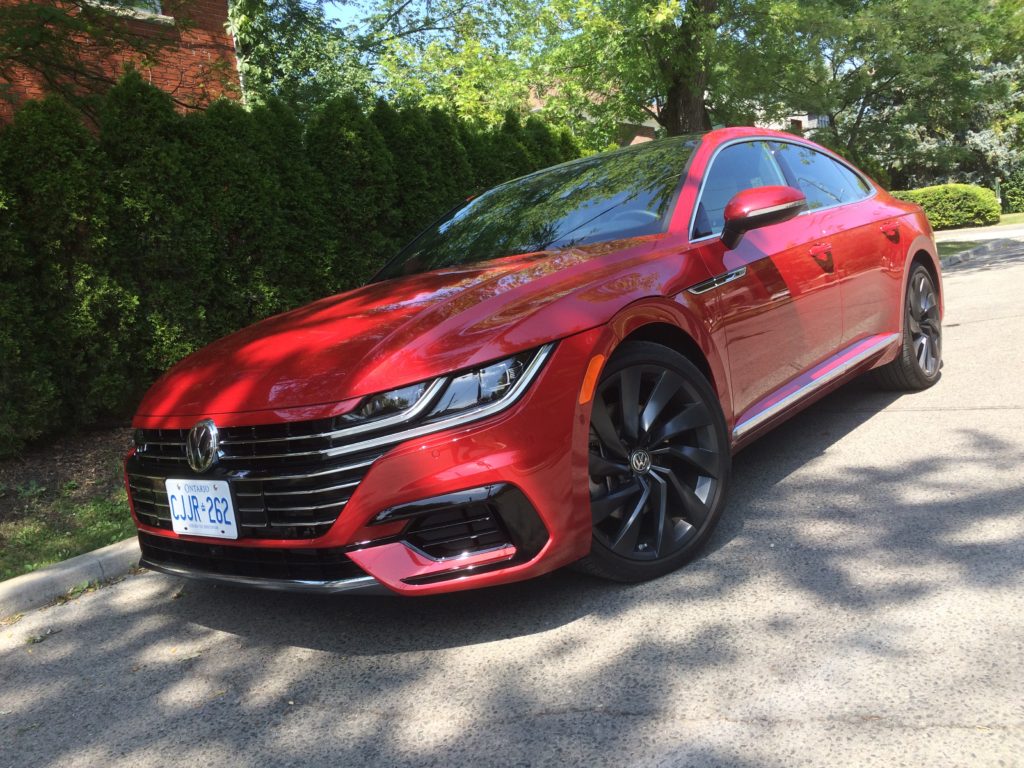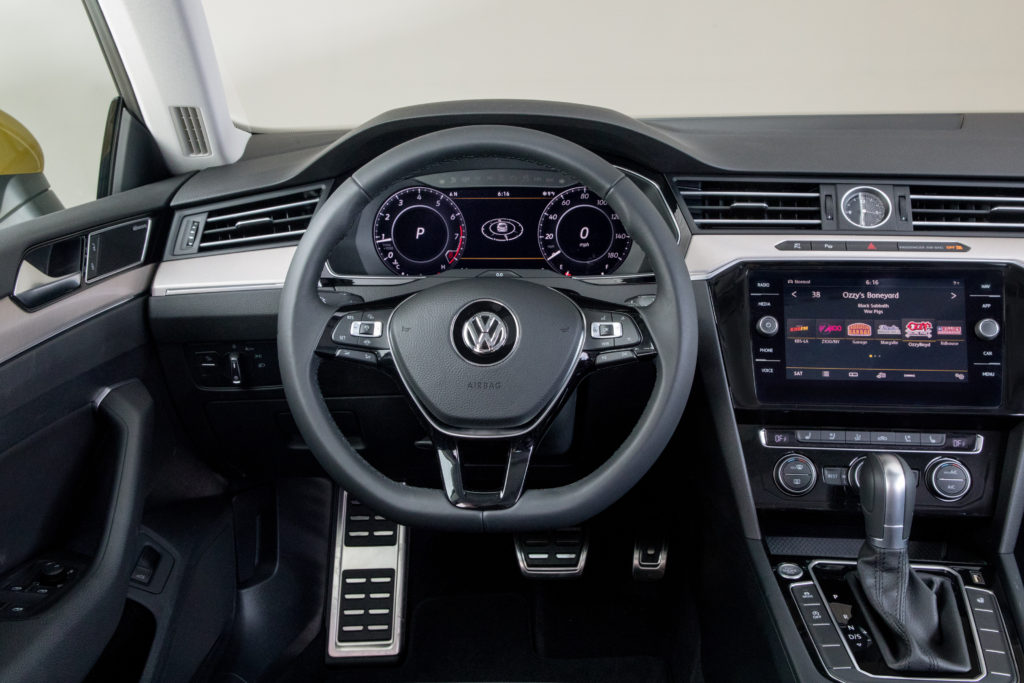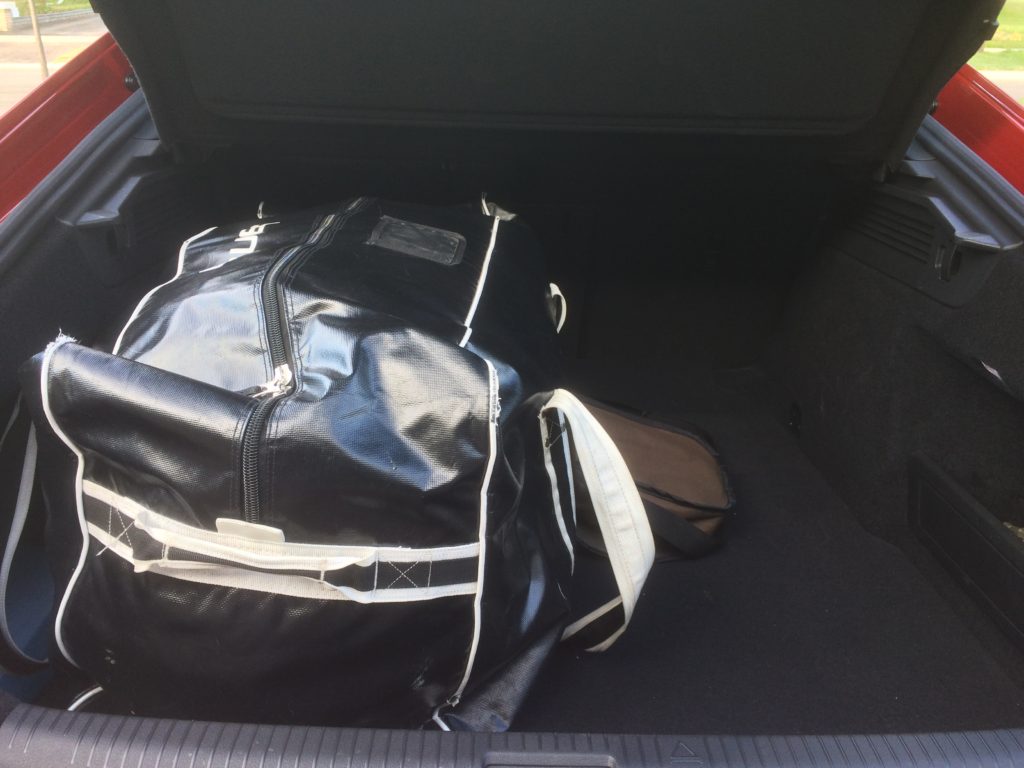There are a few norms in my relationships with automakers whose products I review. One of those is that I normally review one car each week. Recently, due to special circumstances,. I drove not one but two Volkswagens in the same week: the first-ever Arteon and the established Golf Sportwagen Alltrack. So I’ll make this review a comparison of these two capable V-dubs.
First impressions
Both vehicles exude their own type of charm.
Looking for a sleek “fastback” sedan that pushes outside the VW design mold? The Arteon goes beyond the traditional “boxy” look of the people’s car with its muscular hood and haunches (the latter are part of what VW designers call the car’s “character line”), low-profile tires and lowish profile. The design departures were enough to make several people ask me what make of vehicle the Chili Red Metallic Arteon was.

The Peacock Green Metallic Golf, meanwhile, caused no such confusion. The long-established VW air of handsome no-nonsense utility permeates every square inch of the body, from the hood to the shape of the cabin to the near-vertical hatchback to the roof rack rails.
Interior
Straightforward overall designs in both interiors welcome drivers and passengers alike. For the first time in memory, I found my head touching the ceiling of a VW – in this case, the Arteon. There was no such issue in the Golf, in spite of it also sporting a sunroof. (The Golf’s panoramic sunroof, by the way, stretches al the way to the back seats.) Both vehicles feature heated, leather, power-adjustable drivers’ seats. The Arteon’s ventilated seats proved a godsend on the steamy summer days when I drove it.

Tall folk must keep their heads bent in the Arteon’s rear seats, while those of the Golf proved more welcoming. I’m not sure the Arteon’s heated rear seats are enough compensation for this.
Instrument layouts are highly similar, from the placement of the start-stop engine button beside the shift lever to the climate controls to the HVAC vents and so forth.
Visibility is fantastic to the rear blind spots thanks to windows in the C pillars that enable a 360-degree view for the driver in either car.
While the overall feel of the Golf is one of competently assembled utility, the Arteon goes a step beyond. Both feature ambient lighting, but the Arteon adds touches like an analogue clock high up in the dash. I’m told certain reviewers figure this isn’t necessary. They have a point: both the instrument cluster and the touchscreen display the time. My perspective is more nuanced. This isn’t about need. People arguably no longer need watches, but many of us wear them anyway. That analog clock is a luxury touch, one of several that enhances the Arteon’s interior beyond typical V-dub cabin trim. It matches the leather touches, heated steering wheel, contrasting stitching, attractive colours and surfaces that speak of subtle luxury.
One more thing about the clock: its face matches the angle of the dash in which it’s embedded. This means the driver’s head would have to be above the roof to see the “7” and “8” portions of the dial. I would expect VW designers to place the clock vertically in the dash to fix this issue. And please, keep this luxury touch in the Arteon’s cabin.
Hockey bag test
The Arteon’s trunk is not just the cavern typically found in a VW. Designers placed the hinges of the power liftgate not at the base of the rear window but above the window, like that found on the Tesla Model S. This design combines the looks of a sedan with the accessibility of a hatchback, and I hope more models adopt this design.
As for roominess, the Arteon accommodated my hockey bag longitudinally, with more than enough room for a second similarly sized bag. Sticks slid through the centre slot in the rear seat so I did not need to fold either seat down.

The Golf features just as much space and the same rear sear passthrough, although without the power liftgate. (I still like the manual method, though – press the “V” on the VW roundel with your thumb to pop out the “W” portion, put your other fingers under the “W” and lift.)
Once my girlfriend saw the Golf wagon, she figured we could check out a few thrift stores for a small dresser she’s been meaning to pick up. The search ultimately proved futile (we managed 3 stores in under 2 hours), but not for lack of cargo room.
In-cabin technology
VW outfitted the Arteon with its Digital Cockpit, a 12.3” digital instrument cluster. The Golf gets a digital portrait-layout screen between the tachometer and speedometer. At startup, both instrument clusters look much the same. Change the drive mode on the Arteon and the dials reflect the change, but the digital layout never gets overly complex. VW enables screen selections, form audio to drive data to settings and so forth, in both vehicles using the same set of buttons under the driver’s right thumb.
Both cars feature VW’s efficiently designed App-Connect infotainment system. (Smartphone owners can stick to either Apple CarPlay or Android Auto.) A proximity sensor enlarges icons lining the bottom of the 8” touchscreen when an occupant’s hand nears the screen. The effect reminds me of how the icons in a Mac dock react when the mouse pointer travels along said dock. On the VW, though, all icons grow large at once, and shrink back to regular size in unison when the occupant’s hand withdraws.
Dials for on/off/volume and tuning flank the screen. This may seem archaic, but I haven’t yet seen a better way to handle these functions. In handling these dials, it’s easy to touch the “buttons” nearby, particularly when the car hits a bump. When you do touch one of these buttons, the screen’s contents change to display the feature represented by that button. I’d like to see VW change these infotainment controls into physical buttons you would need to press instead of touch. (The cars I drove already have such buttons flanking the shift lever for features like changing the drive mode.)
The Arteon pumps music through a Dynaudio® – 700-watt digital sound package (10 speakers + 1 subwoofer). Music in the Golf gets channeld through a Fender® Premium Audio System – 8 speakers plus subwoofer.
Looking for a CD player? Remember to check inside the glovebox, where you may also find SD card slots. (Minor quibble: the Arteon’s glovebox does not offer enough room for the car’s manual.)
The Arteon offers two USB ports; the Golf, only one.
Driving
The Arteon’s 2.0L TSI engine produces 268 hp and 258 lb-ft of torque. These aren’t earth-shattering numbers, but paired with a responsive transmission, the Arteon proved quick off the mark.
About that transmission: the Arteon makes liberal use of its eight speeds during spirited driving, while the Golf’s six gears can also get a workout if you drive its 1.8L TSI engine that way. VW outfitted both vehicles with paddle shifters on the steering wheels for people who are inclined to take over from the competent automatics both cars sport.
Both cars handled stop-and-go traffic, as well as ordinary highway speeds, with great calm whenever I used the adaptive cruise control (ACC) system. When driving the Arteon in Eco mode and changing from a slow lane to a clear one, it was slow to figure out it had room to accelerate, but VW’s ACC is showing improvement.
It’s amusing to look out the window when starting up either VW. The Adaptive Front Lighting System (AFLS) shines in several directions, up and down, before it settles on a direction in which to shine the LED headlights.
The AFLS is just one of the active safety features the Arteon sports. Side assist, rear cross-raffic alert, park distance control and other technologies will help drivers avoid dings (or worse).
Just for fun, I used the Golf’s parallel parking assist with my girlfriend in the passenger seat. It’s still a new enough technology that she (and other people I’ve done this to) grow quiet as they watch the car turn the steering wheel on its own as it backs into a street parking spot. Regardless, of how new it is, parking assist has never failed me, regardless of vehicle make or model. It appears to be a mature technology, and I expect it to spread into ever more vehicles.
Fuel economy
In both cases, I could rarely manage lower fuel consumption. VW publishes the following numbers for the Arteon: 12.0 L/100km city, 8.6 L/100km highway and 10.4 L/100km combined. (On one highway trip, the Arteon’s onboard fuel economy monitor showed 7.7 L/100km.)
Pricing
The 2019 Arteon 2.0 TSI Execline 4Motion starts at $47,995 MSRP. With options and excluding other fees, my tester retails for $53,085 MSRP.
The base Golf Sportwagen will set you back $36,670. With options and excluding other fees, my tester retails for $38,420.